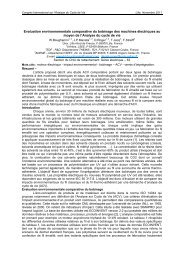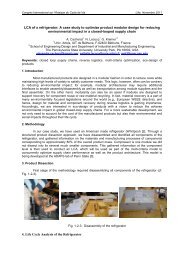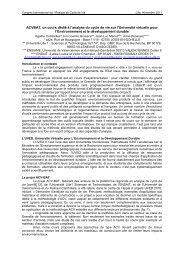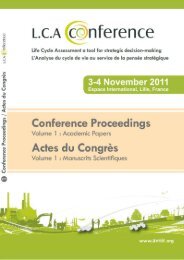Assessing Temporary Carbon Storage in Life Cycle Assessment and ...
Assessing Temporary Carbon Storage in Life Cycle Assessment and ...
Assessing Temporary Carbon Storage in Life Cycle Assessment and ...
You also want an ePaper? Increase the reach of your titles
YUMPU automatically turns print PDFs into web optimized ePapers that Google loves.
7 Appendix<br />
7.1 Need for Relevant Timescales <strong>in</strong> <strong>Temporary</strong> <strong>Carbon</strong> <strong>Storage</strong> Credit<strong>in</strong>g<br />
Susanne Vedel Jørgensen <strong>and</strong> Michael Hauschild<br />
When evaluat<strong>in</strong>g possible global warm<strong>in</strong>g mitigation potential of temporary carbon storage, it should<br />
be recognized that the challenge is two-fold: One aspect is the long-term persistence of anthropogenic<br />
CO 2 <strong>in</strong> the atmosphere, another is the urgent risk of cross<strong>in</strong>g possibly irreversible tipp<strong>in</strong>g po<strong>in</strong>ts. For<br />
the long-term issue, only storage of carbon on timescales long enough to simultaneously remove<br />
carbon from the near-surface parts of the global carbon cycle is relevant <strong>in</strong> terms of mitigation<br />
potential. This contradicts many current suggestions for credit<strong>in</strong>g of temporary carbon storage, only<br />
consider<strong>in</strong>g removal from the atmosphere by natural uptake <strong>in</strong> terrestrial biosphere <strong>and</strong> upper ocean.<br />
From these superficial s<strong>in</strong>ks, the carbon has a great risk of re-emission, due to e.g. global warm<strong>in</strong>g.<br />
Closer exam<strong>in</strong>ation of the global carbon cycle reveals timescales of thous<strong>and</strong>s of years for removal of<br />
carbon from the near-surface parts, whereas regeneration of fossil fuels takes millions of years. Many<br />
current suggestions for credit<strong>in</strong>g temporary carbon storage, however, are based on a 100-year time<br />
horizon for global warm<strong>in</strong>g potential, which seems <strong>in</strong>sufficient compared to the removal times of the<br />
global carbon cycle. It is illustrated how this time horizon disregards the long atmospheric lifetime of<br />
anthropogenic CO 2 , hid<strong>in</strong>g long-term impacts of fossil fuel consumption <strong>and</strong> how the decision on time<br />
horizon is essential for the credit<strong>in</strong>g results, mak<strong>in</strong>g it crucial that the chosen time horizon ensures real<br />
climatic benefits. For the urgency issue however, storage on much shorter timescales may have a<br />
‘bridg<strong>in</strong>g potential’ <strong>in</strong> terms of buy<strong>in</strong>g time. For this aspect, timescales need only be long enough to<br />
reach <strong>in</strong>to a more carbon neutral future. It is recommended to separate credit<strong>in</strong>g of global warm<strong>in</strong>g<br />
mitigation potential for the long-term issue <strong>and</strong> the short-term bridg<strong>in</strong>g potential, so possible shortterm<br />
solutions can be acknowledged without appear<strong>in</strong>g to solve long-term problems.<br />
23
















